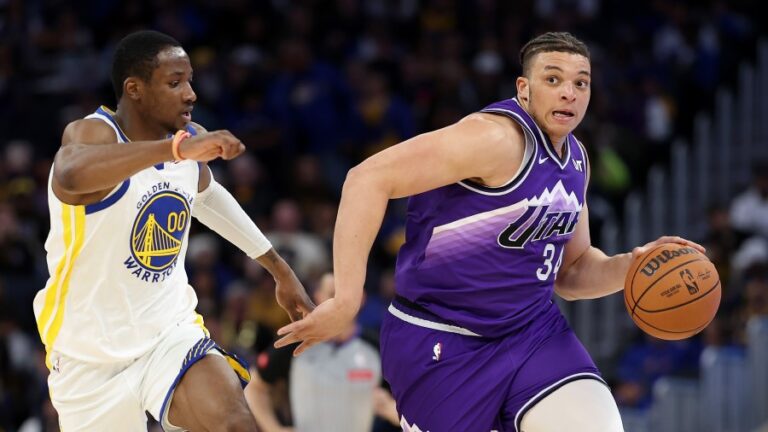Table of Contents
Introduction
The Utah Jazz recently made headlines with a surprising move: they’ve waived Darius Bazley and Kenneth Lofton Jr. This decision has stirred up quite a buzz among fans and analysts alike. If you’re scratching your head wondering what this means, don’t worry—let’s break it down.
First off, waiving a player basically means the team is letting them go, making them available to join other teams or hit free agency. For the Jazz, this is a strategic decision that can impact their lineup and future plans. Darius Bazley and Kenneth Lofton Jr. were both part of the team’s roster, but the Jazz decided it was time to part ways with them.
But why? That’s the million-dollar question. The decision to waive players often involves a mix of factors, from financial considerations to team strategy. For fans of the Jazz, it’s a moment to reflect on what this change might mean for their favorite team.
In the upcoming sections, we’ll dive into who Darius Bazley and Kenneth Lofton Jr. are, why they were with the Jazz, and what this move could mean for the team’s future. Stay tuned as we explore the implications of these waivers and what’s next for the Jazz.
Background on Darius Bazley
Darius Bazley is a name that NBA fans might recognize, but if you’re new to following basketball or just catching up, here’s a quick primer. Bazley was a highly touted prospect when he entered the NBA, known for his impressive athleticism and potential. Drafted in 2019 by the Oklahoma City Thunder, he quickly became a player to watch.

Bazley joined the Utah Jazz as part of their roster, and his time with the team was marked by moments of promise. He brought energy and versatility to the court, often showcasing his skills in both offensive and defensive plays. His stats were decent, but sometimes, teams need to make tough choices, and that’s exactly what the Jazz did.
So, why did the Jazz decide to part ways with him? It’s not always about a player’s talent; sometimes, it’s a matter of fit within the team’s overall strategy or financial considerations. For Bazley, it could be a combination of things, including how well he meshed with the current roster or the team’s plans for future development.
In the next part, we’ll dig into what Bazley’s departure means for the Jazz and how it might impact the team moving forward. If you’re a fan or just curious about how these changes shake out, keep reading to get the full picture.
Background on Kenneth Lofton Jr.
Kenneth Lofton Jr. might not be as well-known as some of his NBA peers, but he’s been making waves since his entry into the league. Lofton Jr., a standout player in college basketball, caught the eyes of scouts with his strong performances and physical presence. After going undrafted in 2022, he signed with the Utah Jazz, eager to prove himself in the professional arena.

During his stint with the Jazz, Lofton Jr. had his moments to shine. Known for his size and skill in the paint, he brought a unique edge to the team. His contributions included valuable minutes on the floor and glimpses of the potential that made him a noteworthy prospect. However, like with any team, decisions must be made about who fits best with the overall strategy and future goals.
So why did the Jazz decide to let him go? The reasons can be quite varied. It might be about finding the right fit with the team’s long-term vision or making room for new talent. Sometimes, it’s also about managing the team’s finances or adjusting the roster to better suit upcoming strategies.
Next, we’ll dive into what this move means for the Jazz and how it could affect the team’s plans. Whether you’re a die-hard fan or just intrigued by the changes, stick around to see what’s next for the Jazz after this shake-up.
Team Impact and Analysis
So, what does it mean for the Utah Jazz to part ways with Darius Bazley and Kenneth Lofton Jr.? Let’s break down the impact of these decisions on the team’s roster and future plans.

Immediate Impact on the Jazz Roster
First off, waving Bazley and Lofton Jr. means the Jazz are making room for new possibilities. With two spots now open, the team has a chance to reshape their roster. This could lead to bringing in fresh talent, whether through free agency, trades, or promoting players from within. For the current roster, it might create new opportunities for other players to step up and make their mark.
Future Implications
Looking ahead, these moves could signal a shift in the Jazz’s strategy. The team might be preparing for a change in their playstyle or looking to build a different kind of team chemistry. It’s also possible that these waivers are part of a larger plan, perhaps setting the stage for significant trades or new signings. Fans should keep an eye on how the Jazz adjust their lineup and strategy in the coming months.
Cap Space and Financial Considerations
From a financial perspective, waiving players can also have a big impact. By letting Bazley and Lofton Jr. go, the Jazz might free up some salary cap space. This extra room could be used to sign new players, extend contracts, or make other financial moves that could benefit the team in the long run. Understanding these financial dynamics helps explain why the Jazz might have made these decisions.
In the next section, we’ll explore how fans and media are reacting to these moves and what experts are saying about the Jazz’s decision. If you’re curious about how these changes are being viewed from different angles, stay tuned!
Reactions and Commentary
Whenever a team makes significant changes, like waiving Darius Bazley and Kenneth Lofton Jr., the reactions are swift and varied. Let’s dive into how fans and media are responding to these moves, and what experts are saying about the Utah Jazz’s decision.
Fan and Media Reactions
Fans and sports media are buzzing about the Jazz’s decision to part ways with Bazley and Lofton Jr. On social media, you’ll find a mix of surprise, disappointment, and curiosity. Some fans are scratching their heads, wondering if the Jazz made the right call. Others might be optimistic, hoping these moves are a sign of bigger, positive changes on the horizon.
Media outlets are also weighing in, offering their takes on why the Jazz might have decided to waive these players. Some reports suggest it’s part of a larger strategy to shake up the roster and bring in new talent. Others focus on the financial aspects, noting how these moves could help the team manage their salary cap more effectively.
Expert Opinions
Sports analysts and commentators are analyzing the waivers from various angles. Many are offering insights into how these changes could impact the Jazz’s overall strategy and performance. Some experts believe these moves are a step towards a more focused team-building approach, potentially setting the stage for future success.
Others are discussing the potential challenges the Jazz might face in adjusting to these changes. They might highlight the need for new players to step up and fill the gaps left by Bazley and Lofton Jr., and how this could affect the team’s chemistry and performance on the court.
In the next section, we’ll wrap things up with a summary of the key points and take a look at what might be coming next for the Utah Jazz. If you’re eager to see how these changes fit into the bigger picture, keep reading!
Conclusion
To wrap things up, let’s take a moment to summarize what we’ve covered about the Utah Jazz waiving Darius Bazley and Kenneth Lofton Jr. and look ahead at what might be next for the team.
Summary of Key Points
The Utah Jazz’s decision to part ways with Darius Bazley and Kenneth Lofton Jr. is a significant move that has stirred up plenty of discussion. Both players brought unique skills to the team, but the Jazz decided it was time to make a change. Bazley and Lofton Jr. were known for their potential and contributions, but the team’s decision reflects a broader strategy that involves reshaping the roster.
Looking Ahead
So, what’s next for the Jazz? With these waivers, the team now has openings that could lead to new opportunities for fresh talent. Keep an eye out for potential trades, new signings, or promotions from within the team. These moves could signal a shift in how the Jazz plan to build their roster and what kind of team they’re aiming to become.
As the Jazz continue to adjust and adapt, fans and analysts will be watching closely to see how these changes play out. The next few months could bring exciting developments as the team works to solidify their lineup and set their sights on future goals.
Whether you’re a dedicated fan or just interested in how these changes might unfold, staying tuned to the Jazz’s moves will be key to understanding their evolving strategy and prospects for the upcoming season.




